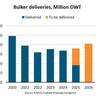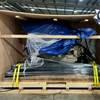Freight Rates in Europe-ECSA Trade Continue Declines
Container volumes from North Europe and the Mediterranean to the East Coast of South America have now fallen in 26 of the previous 28 months, with the latest statistics from Datamar showing that shipments fell by 8% year-on-year in July.
It is the smaller Med to ECSA trade that continues to experience the largest fall-off in volumes with the Datamar figures showing that exports from the Med were down by 12.2% Y/Y after seven months of 2016 to 117,500 teu; versus a decrease of 8.8% for North Europe exports to 306,400 teu.
Figure 1
Southbound Europe to ECSA container traffic (‘000 teu)
(See Figure 1)
The trade is very closely balanced with generally only a few thousand teu’s difference between the south and northbound legs each month, although the latter continues to gain ground and is on course to be the dominant leg for the second year running. Datamar numbers show that the more reefer-heavy northbound trade from ECSA to North Europe and the Med was broadly unchanged in June and July, which represents a downshift from 13 months of continuous healthy growth.
Nonetheless, northbound volumes were up by 7.1% after seven months of 2016 with Mediterranean imports, in contrast to the southbound leg, at the forefront with year-to-date growth of 17.6%. The Med is a vital transhipment hub for box traffic from ECSA to West Africa and the Middle East. In contrast, volumes from ECSA to North Europe were only up by 1.7%, although it remains the bigger trade by a ratio of 2:1 teu.
Figure 2
Northbound ECSA to Europe container traffic (‘000 teu)
Fig 2 Notes Preliminary data; All data includes dry, reefer and tank cargoes Source Datamar
The rolling 12-month average for both legs indicates a plateauing effect in recent months with northbound growth settling at about 7%, while the southbound trade is scraping along at -12%. It is possible that both arrows will look more positive come the end of the year as while the ECSA region remains economically troubled, there are tentative signs of recovery. For example, the IMF recently upgraded its GDP forecast for Brazil next year to 0.5% having previously expected a deficit.
Figure 3
12-month rolling average of Europe to ECSA container traffic (% change on previous year)
Notes Preliminary data; All data includes dry, reefer and tank cargoes Source Drewry Maritime Research (www.drewry.co.uk), derived from Datama
Up until last month carriers did not touch capacity on this route at all with virtually the same number of slots being available to the market in both directions from April through to July. The slot count did drop marginally in August, but capacity was still about 4% higher than in the same month last year.
With demand also barely moving on a month-to-month basis inevitably there was very little change in our assessment of average ship utilisation. In the southbound trade, where some space is required for the reposition of empty reefer containers back to ECSA, ships are less than half full, while northbound utilisation has been stuck at around 75% for three months.













